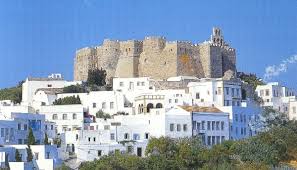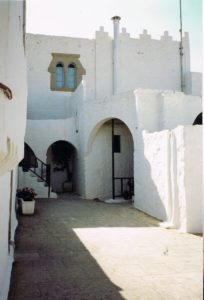From a distance, the island of Patmos looks like lumps of clay. As the ferry draws nearer, turning into the deep bay toward the Port of Skala, the lumps dissolve into a volcanic, mountainous mass. Here and there clusters of square-topped houses, gleaming in whitewashed starkness, cling together. At the top of the second-highest mountain peak stands a fortress surrounding the Monastery of St. John the Divine.
This is what sets Patmos apart from the hundreds of other Greek islands: it is a Christian holy place, a place of pilgrimage.
In the year 95 C.E. a large galley ship drawn by slaves glided into the main port of the island. It had come from Ephesus, 75 km to the east on the coast of Asia Minor (now Turkey). Like most of the ships heading for Patmos, it carried prisoners, many of them well educated and from prominent families.
Patmos was a place of banishment
Patmos was a place of banishment, an abandoned pile of rocks where the men would live out their days laboring in stone quarries under the lash of the military guards and sleep in the innumerable damp, dark caves at night.
The crossing had been rough, and as the ship tossed about violently, a wave suddenly lashed over the vessel and carried off one of the passengers. And then, just as suddenly, another wave tossed him back. The miracle happened, it was said, because of the prayer of one of the prisoners who had raised his chained hands in benediction over the sea.
The prisoner’s name was John.
John’s arrival on Patmos was eventually to have the effect of transforming the island from a place of exile into one of the holy shrines of Christendom. This was where he was said to have written the fiery tract called the Apocalypse, or the Book of Revelation, later to become the final book of the Bible.
John was a leader of considerable importance within the new movement which followed the teachings of the man called Jesus. At first the movement was simply called “the Way” and later became known as Christianity as it spread north from Palestine into Asia Minor and south into Egypt.
It is not known where John originally came from. Scholars no longer think that he was the same person as John the Evangelist, who wrote the Gospel of John and who may have been one of Jesus’s apostles. History knows that John the Divine, or John the Theologian as Revelation’s author is now known, lived in Ephesus, the seaport and cultural center where the great temple of Artimis, rising with shining pillars above the harbor, was one of the seven wonders of the world. At Ephesus, he had helped to form a church, or assembly of people who had been newly converted to the new faith.
Belonging to this new religion was a risky business. Not only did Christians turn their backs on the ancient worship of Artemis and the other gods and goddesses, but they also took the politically dangerous stand of refusing to acknowledge the emperor’s divinity. For many, the result was punishment by death. John’s fate was exile to the dreaded island of Patmos.
In one of the damp caves on Patmos, with water dripping upon him and the taste of seasalt on his lips, John had a series of visions of the world’s immanent end. He dictated what he saw to his scribe, Prochorus, who had been exiled with him.
The visions are lurid
His descriptions are lurid: Michael the archangel leads the heavenly forces, fighting for the neophyte Christian Church against the powers of evil, embodied in the Roman Empire. Rome is the “whore of Babylon”, with whom “the kings of the earth have committed fornication.”
John foresees that Rome will undergo a series of punishments: a plague of locusts, disease, slaughter, a relentlessly blazing sun followed by a plunge into darkness. Finally, an earthquake will lay Rome to waste once and for all and only the followers of Christ, those who have been “washed in the blood of the Lamb” will be saved. A new heaven and a new earth will be formed, where there will be no more tears, “no more death or mourning, crying out or pain.”
One can imagine John’s anger at the injustice meted upon his fellow convicts, most of whom were to suffer the brutal torture of life-long slave labor on the rocky island. The saint himself, however, spent only about 18 months on Patmos, returning to Ephesus after the death of the Emperor Domition, when the persecutions subsided.
Patmos eventually became abandoned in the centuries following the fall of Rome, until the year 1088 when the monk Christodoulos, searching for a barren place where he could build a monastery, arrived. The deserted island suited his taste, and he set about having the monastery built, a labyrinthine series of white structures connected by courtyards and archways, the whole thing fortified by a thick stone wall.
Some of the inhabitants of modern-day Patmos are the descendents of the workmen employed by Christodolous to build his monastery. (The monk, zealous in his quest for a life free from distractions, at first refused to allow his builders to bring their wives and families to the island; later, he was obliged to relent.) At 34.6 square kilometres and 15 km long, Patmos is among the smallest of the islands forming the Dodecanese, the easternmost group of islands in the Aegean Sea.
From Skala, the road winds up to Chora, the other main town on the island, beyond which is Christodoulos’s Monastery of St. John the Theologian. A place of quiet calm despite the stream of tour groups from cruise ships, the monastery houses the remains of Christodoulos, set in a marble sarcophagus, as well as a number of frescoes and icons dating from the 17th century. The monastery’s treasury contains a stunning collection of Byzantine vestments, embroideries, and sacred vessels, as well as 900 ancient manuscripts. The oldest text is a 6th century fragment of the Gospel of Mark.
From Chora, the visitor can descend along an old Roman road rebuilt by the Italians during their occupation of the island in the early 1900s, to the Monastery of the Apocalypse which enshrines the Grotto of the Revelation. Here is the place, it is said, where the visions of the Apocalypse appeared to John.
At the entrance a bearded monk notes visitors’ attire
At the entrance a bearded monk notes visitors’ attire; he hands out towels to men wearing shorts and skirts to women in shorts or pants. The visitors hoist the makeshift garments onto themselves before entering.
Inside the cave, which is about 4 metres deep, the rock is divided by a dramatic triple fissure, from where, according to legend, John heard the voice of God. Hewn into the rock is a cross carved by Christodoulos. A natural stone shelf at the bottom is the place where the saint is said to have laid his head when he slept.
Patmos is now a retreat for wealthy Europeans and Americans who have built villas with 180-degree views of the sea, but the simplicity and piety of the people of the island help to maintain the quiet and reserve one associates with places of pilgrimage. On Sunday mornings commerce halts as, in round white Greek Orthodox churches, women pray in the outer porch while men mingle and, inside, bearded priests in golden robes chant and move about with incense.
For anyone whose spiritual roots lie in the Judeo-Christian tradition, travel to the eastern Mediterranean in the spirit of pilgrimage provides a significant connection with those roots. Spiritual texts come alive when one climbs the same rocks, walks the same dirt paths that the 4 writers of those works trod. And not only antiquity springs to life. After one has touched the cleft in the rock or climbed the hills of Patmos, one can no longer hear the final majestic chorus of Handel’s Messiah (“Worthy is the Lamb that was slain”, taken from the Book of Revelation) as simply a work of musical genius. It becomes as well an expression of faith.
When John wrote about weeping and mourning, he could have been writing about today
To be a pilgrim in Patmos is also to be aware that not far from here, life is not so tranquil. Here, as darkness descends upon the island and you listen to the far-away wail of the sea-birds and smell the warm, salty Mediterranean air, you know that on the mainland some miles to the east there is war and poverty and suffering on a scale hardly envisioned by the writer of the Book of Revelation. When he wrote about weeping and mourning, he could have been writing about today.
—The Pastoral Review, July/August 2009



